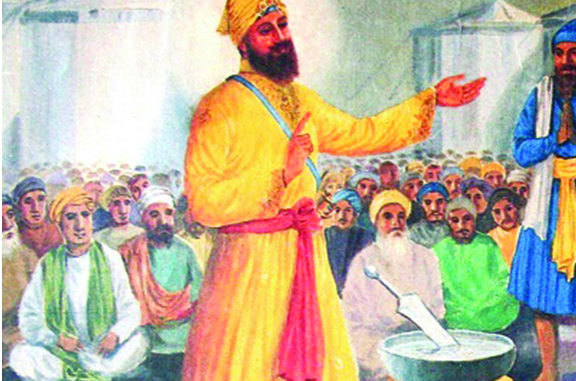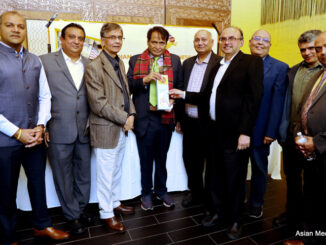
Following the death of Teg Bahadur, Guru Gobind Singh (1666-1708), the most important of all the Gurus with the exception of Guru Nanak, assumed leadership of the Sikhs. Gobind Rai, whose name was altered to Gobind Singh possibly at the time of the creation of the Khalsa, was born in Patna, the only child of Guru Teg Bahadur. At the age of five he was brought to Anandpur and educated in Sanskrit and Persian and in the arts of poetry and warfare. His father’s execution in Delhi by Aurangzeb must have made a deep impression on the child. For several years after his succession as Guru, he continued his education in the Shiwalik Hills. He grew to manhood as the ruler of a small Shiwalik state, participating in various wars against other Shiwalik chieftains and demonstrating a particular delight in the sport of hunting.
According to Sikh tradition, on Baisakhi Day late in the 17th century (1699), a fair was held at Anandpur, and all Sikhs were ordered to attend. The Guru remained concealed until the celebrations were at their height, when he suddenly appeared from a tent carrying a drawn sword and demanding the head of one of his loyal followers.
At once the crowd became silent, wondering what had happened. The Guru repeated the command, and eventually Daya Singh volunteered and was taken behind a screen to be dispatched. Gobind Singh then reappeared, his sword dripping blood, and demanded a second victim. He too was escorted behind the screen, and again the sound of the sword could be heard. In this manner five loyal Sikhs agreed to die for their master. When he had apparently dispatched the fifth, the screen was removed, and all five were seen to be very much alive. At their feet lay five slaughtered goats. The five volunteers became the Panj Piare, the “Cherished Five,” who had proved that their loyalty was beyond question.
Guru Gobind Singh explained that he desired the Panj Piare to be the beginning of a new order, the Khalsa (“the Pure,” from the Persian khalisah, also meaning “pure”). The masands (many of whom had become quarrelsome or corrupt) would be eliminated, and all Sikhs, through their initiation into the Khalsa, would owe allegiance directly to the Guru. Gobind Singh then commenced the amrit sanskar (“nectar ceremony”), the service of initiation for the Panj Piare. When the rite was concluded, the Guru himself was initiated by the Panj Piare. The order was then opened to anyone wishing to join, and Sikh tradition reports that enormous crowds responded.
It should be noted that, contrary to the belief of many Sikhs, some central features of the present-day Khalsa did not exist in Gobind Singh’s time. For example, although the Guru required that those initiated into the Khalsa carry arms and never cut their hair (so that at least the men would never be able to deny their identity as Khalsa Sikhs), the wearing of the “Five Ks”-kes or kesh (uncut hair), kangha (comb), kachha (short trousers), kara (steel bracelet), and kirpan (ceremonial sword)-did not become an obligation of all Sikhs until the establishment of the Singh Sabha, a religious and educational reform movement of the late 19th and the early 20th century.
The Sikh wedding ceremony, in which the bride and groom walk around the Guru Granth Sahib, is also a modern development, having replaced the essentially Hindu rite, in which the bride and groom walk around a sacred fire, by the Anand Marriage Act of 1909. The names Singh (“Lion”) for Sikh males and Kaur (“Princess”) for Sikh females, formerly adopted upon initiation into the Khalsa, are now bestowed to all Sikhs in a birth and naming ceremony (see below Rites and festivals). All of these changes have been incorporated into the Rahit, the Sikh code of belief and conduct, which reached nearly its final form in the early 20th century.
Guru Gobind Singh believed that the forces of good and evil in the world sometimes fall out of balance. When the forces of evil become too great, Akal Purakh intervenes in human history to correct the balance, using particular human individuals as his agents. In Gobind Singh’s time the forces of evil, represented by the Mughals under Aurangzeb, had gained the ascendance, and it was Gobind Singh’s task, he believed, to right the balance. In the service of this mission, the Sikhs were justified in drawing the sword. He expressed this conviction in Zafar-nama (“Epistle of Victory”), a letter that he addressed late in life to Augangzeb. Soon after the creation of the Khalsa, the Guru was attacked by other Shiwalik chieftains in league with the Mughal governor of the town of Sirhind. In 1704 he was compelled to withdraw from Anandpur, losing two of his four sons in the battle that followed. The two remaining sons were taken prisoner and delivered to the governor of Sirhind, who cruelly executed them by bricking them up alive. The fate of these two children has remained an agonizing tale for Sikhs ever since. From Anandpur, Guru Gobind Singh escaped to southern Punjab, where he inflicted a defeat on his pursuers at Muktsar. He then moved on to Damdama, remaining there until 1706 and, according to tradition, occupying himself with the final revision of the Adi Granth. When Aurangzeb died in 1707, Gobind Singh agreed to accompany Aurangzeb’s successor, Bah?dur Sh?h, to southern India. Arriving at Nanded on the banks of the Godavari River in 1708, he was assassinated by agents of the governor of Sirhind.
Source: Britannica.com





Be the first to comment